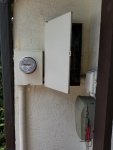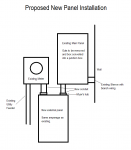Coppersmith
Senior Member
- Location
- Tampa, FL, USA
- Occupation
- Electrical Contractor
Anybody got a good solution for replacing this panel? I can't come up with anything easy.
Conditions:
* All the branch wiring is coming through one 2" PVC chase pipe so I expect the inspector to say they need to be separated for conduit fill and derating reasons. I'm guessing that all the branch wiring is coming down from the attic inside the block core but it could be between the block face and the drywall.
* The cables are NM so not allowed in outdoor conduit.
* There is just 19" between the wall where the pipe emerges and the meter can.
* The walls are block and the other side of the pipe wall is a bedroom.
* The panel is mounted on a wing wall. The other side is a separate residence. This is a duplex.
* There are eleven 20 amp 120v, three 30 amp 240v, and two 50 amp 240v circuits.
The best solution I can think of is to:
* Remove the pipe.
* Cut a vertical channel about 2" wide and 16" tall in the block outside with the pipe hole at the bottom.
* Mount a 4x18 NEMA 3R trough over the channel (against the wall) with the NM cables in individual NM connectors. (The connectors will not be accessible after install. Is this a problem?)
* Connect the new panel to the trough via a sufficient number of pipes to meet derating and fill requirements (probably 3).
* Run THHN from trough to panel making joints in trough.
* The new panel will have to be mounted below the meter can.
* Correct me if I'm wrong. I think no AFCI's will be required since the extensions to the wires will be less than six feet.


Conditions:
* All the branch wiring is coming through one 2" PVC chase pipe so I expect the inspector to say they need to be separated for conduit fill and derating reasons. I'm guessing that all the branch wiring is coming down from the attic inside the block core but it could be between the block face and the drywall.
* The cables are NM so not allowed in outdoor conduit.
* There is just 19" between the wall where the pipe emerges and the meter can.
* The walls are block and the other side of the pipe wall is a bedroom.
* The panel is mounted on a wing wall. The other side is a separate residence. This is a duplex.
* There are eleven 20 amp 120v, three 30 amp 240v, and two 50 amp 240v circuits.
The best solution I can think of is to:
* Remove the pipe.
* Cut a vertical channel about 2" wide and 16" tall in the block outside with the pipe hole at the bottom.
* Mount a 4x18 NEMA 3R trough over the channel (against the wall) with the NM cables in individual NM connectors. (The connectors will not be accessible after install. Is this a problem?)
* Connect the new panel to the trough via a sufficient number of pipes to meet derating and fill requirements (probably 3).
* Run THHN from trough to panel making joints in trough.
* The new panel will have to be mounted below the meter can.
* Correct me if I'm wrong. I think no AFCI's will be required since the extensions to the wires will be less than six feet.


Last edited:


